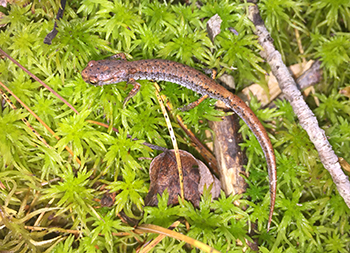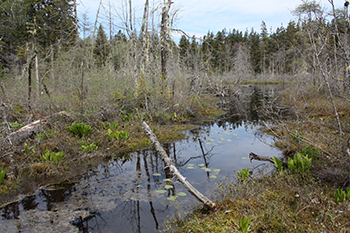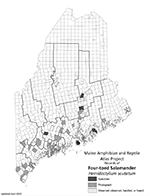Home → Fish & Wildlife → Wildlife → Species Information → Reptiles & Amphibians → Four-toed Salamander
Four-toed Salamander
Hemidactylium scutatum
On this page:

Photo: Trevor Persons
Distinguishing Characteristics

Photo: Trevor Persons
- Small, approximately 2 to 3.5 inches in length
- Reddish brown back, grayish-blackish sides, belly is bright white with black spots
- Four (versus five) toes on hind feet, only native Maine salamander with this feature
- Pronounced constriction at base of tail
Status and Distribution in Maine
- Uncommon
- Southern, central, and eastern regions
Habitat

Photo: Trevor Persons
- Found in close association with sphagnum moss, living in and under moss or rotting wood
- Forested uplands, forested wetlands, and sphagnum bogs
Diet
- Eats invertebrates including beetles, moths, spiders, and mites
Seasonal Changes
- Presumably hibernate in underground retreats beneath forest floor
Natural History Notes
- Maine’s smallest terrestrial vertebrate
- Secretive habits; probably more common than few records suggest
- Breeds in late summer and fall; eggs are laid the following spring
- Eggs laid in cavities in moss or grass that directly overhang small ponds or slow streams
Share Your Sighting
There is much still to learn about the distribution and ecology of Maine’s herpetofauna, and we encourage members of the public to share their photo-documented observations as part of the Maine Amphibian & Reptile Atlas Project (MARAP).
To see if a township still needs documentation of a species, consult this distribution map (PDF). If a township lacks a photo or specimen record, we want your observation!
There are two ways to share your observations:
Submit your reptile or amphibian observation online
No service? No problem. Click here to download the survey to your device while connected, then take offline to collect observations from anywhere. Tip: The survey works best on Google Chrome and Safari.
Or upload sightings to the iNaturalist citizen science project through their website at iNaturalist.org or mobile app.
- When submitting an observation through iNaturalist add a description of the location (and other noteworthy information) to the “notes” field. This serves as a check on the locations automatically generated by smartphone cameras, which may be imprecise if cell service or GPS coverage is weak.
Thank you for doing your part to help conserve Maine’s reptiles and amphibians.
